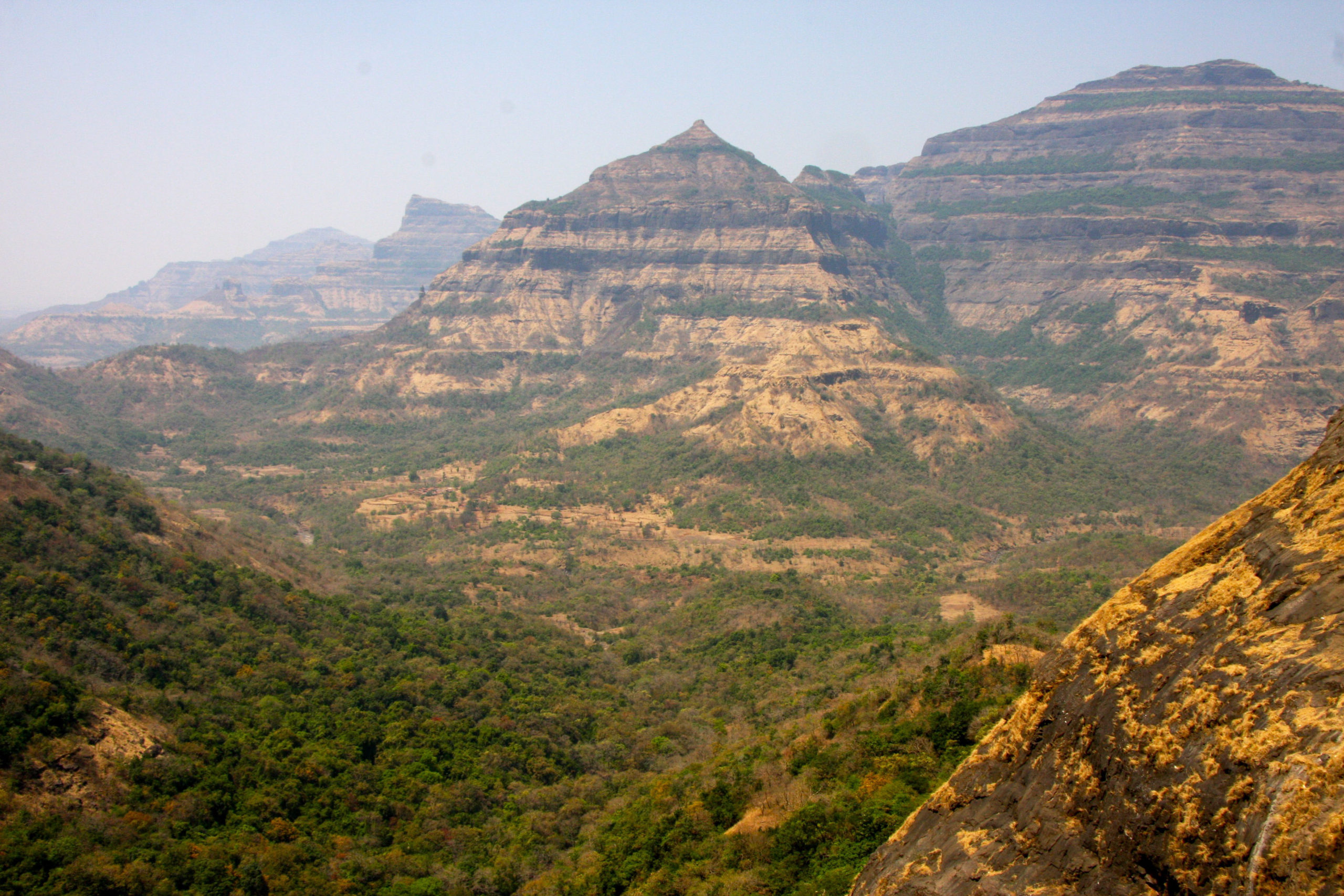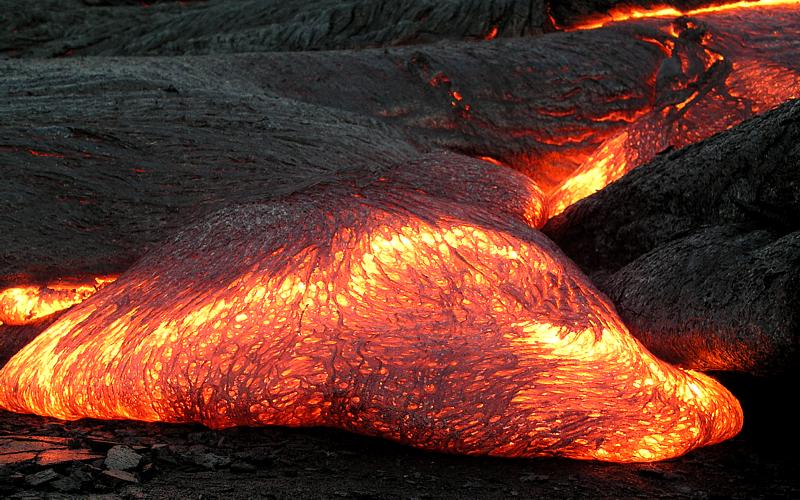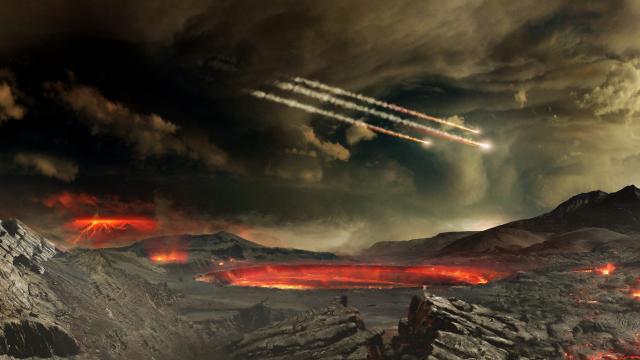For nearly forty years, paleontologists have argued over what really killed the dinosaurs. Was it an massive asteroid impact, or a spate of volcanic eruptions? Or what if a powerful impact ignited volcanoes, walloping Earth’s biosphere with a deadly 1-2 punch?
That double-whammy scenario has been around for a while, but new evidence to support it may help settle the long-standing debate over the Cretaceous-Tertiary (KT) mass extinction. In a study which appears in this week’s Science, a UC Berkeley-led researcher team makes a compelling case that the impact at Chicxulub crater in Mexico triggered a period of large volcanic eruptions, turning Earth’s atmosphere into a dusty, noxious mess for the next 500,000 years.
“We like simple answers: The dinosaurs died of an impact,” paleontologist Paul Sereno of the University of Chicago told Gizmodo by phone. “But there are always more layers when you start to dig into these things.”
Partners in Crime
The asteroids vs. volcanoes debate traces all the way back to the discovery of the Chicxulub crater off Mexico’s Yucatan Peninsula in 1980. When the impact was dated to 65.5 million years ago — precisely the same age as the KT boundary — it was lauded as smoking gun evidence that an asteroid triggered the mass extinction that doomed the dinosaurs. But around the same time, other researchers were finding that a series of massive lava flows in India called the Deccan Traps also coincide with the KT boundary. The paleontology community was thus polarised over what caused one of the most dramatic extinction events in Earth’s history.

Layered lava flows in the Deccan Traps east of Mumbia, India. Image Credit: Mark Richards/UC Berkeley
But it seems awfully coincidental that these two natural disasters should strike the Earth at almost exactly the same time. Could they be related? Earlier this year, a team of geoscientists including Paul Renne and Mark Richards at UC Berkeley proposed exactly that. Perhaps the tremendous energy of the Chicxulub impact — which has been compared to a magnitude 11 earthquake — shook up volcanoes worldwide, inciting a period of larger and more deadly eruptions.
“As an analogy, if you take a bowl of wet sand and start shaking it, it fluidizes,” Richards said. “You can actually get the water to start expelling in spouts. Likewise from the historical record, we know that volcanoes are sometimes triggered by earthquakes.”
Indeed, the link between volcanic eruptions and large, distant earthquakes has been known for some time. Richards points out that the largest earthquake in recorded history — the magnitude 9.5 quake that struck Chile in 1960 — incited volcanic eruptions in the Andes.

Animation showing the impact and subsequent crater formation at Chixculub. Image Credit: University of Arizona, Space Imagery Center.
To test the hypothesis that a KT impact could have kicked volcanoes into high gear, Renne, Richards and their colleagues revisited the Deccan Traps and collected samples from lava flows east of Mumbai that surround the KT boundary. The researchers used an argon-isotope dating technique to determine the precise age and size of volcanic eruptions represented in the geochronology.
Within 50,000 years of the impact at Chixculub crater, the team found that the magma eruption rate had doubled, with small, frequent eruptions giving way to much more voluminous outbursts. In the half million years following the impact, the Deccan Traps released enough lava to bury the state of California a mile deep.
“The rate of eruptions and magnitude of the lava flows changed dramatically following the KT boundary,” Renne told Gizmodo. “The evidence for a linkage between these events has been known before, but it hasn’t been tied together like this.”
Shaking Up Earth’s Plumbing System
According to Renne, it wasn’t just the size of volcanic eruptions in India that shifted after the KT boundary: So did the chemical nature of the magma itself.
When hot magma bubbles up from Earth’s mantle toward the surface, it melts crustal rock along the way. By the time an eruption occurs, the lava contains a mixture mantle and crust-derived minerals.
“Right up until this change, the lavas show very strong chemical evidence that in the process of rising, they got contaminated by Earth’s crust,” Renne said. “They’re especially contaminated by crust right before the transition. And then, bam! Across the [KT] boundary, you get into much more pure mantle-derived magmas — magmas that haven’t consumed a bunch of crustal material.”

Lava flow on Hawaii. Image Credit: Wikimedia
To geologists, a chemical transition of this nature implies that major structural changes are taking place within the volcano’s plumbing system. Specifically, magmas that are more mantle-rich are thought to have had less contact with Earth’s crust on their way to the surface.
“The most logical explanation is that we’re going from a number of small magma chambers to one or two relatively large magma chambers,” Renne said. “That means there has to suddenly be communication between these separate chambers. A major shock can induce increased permeability, so that magma can more easily flow through the rocks it’s being stored in.”
Renne and Richards are still trying to work out the exact nature of the physical changes that took place within the Deccan Traps volcanoes around the KT boundary. But it’s fascinating (and a bit terrifying) to imagine a single asteroid impact rattling the Earth’s crust like this.
Other geologists think that the mechanism is plausible, but believe a different asteroid, or even a series of impacts, could have been responsible. “The location of the Deccan plume and the Chicxulub crater attributed to end-Cretaceous extinction time were antipodal, on the opposite of the globe,” paleontologist Sankar Chatterjee of Texas Tech University told Gizmodo by email. “It would be more convincing if the impact was proximate to Deccan volcanism site.” In his own research, Chatterjee has proposed a link between Deccan Traps volcanoes and the Shiva crater off the coast of Western India — the remnants of another large body which struck the Earth around the KT boundary.
Case Never Closed
Asteroid impacts and volcanic eruptions both do a number on Earth’s biosphere. Both kick plumes of dust and carbon dioxide into the air, blocking out the sun and sometimes choking out life. Volcanic eruptions also belch out sulfate aerosols, which circulate in the upper atmosphere for hundreds to thousands of years before raining back to Earth as sulfuric acid. Regardless of which did more damage, the combination of these two violent agents seems to have made the post-Cretaceous Earth a pretty hellish place for a long, long time.

Image: Shutterstock
Renne, for his part, is somewhat agnostic about which factor really was the coup de grâce for the dinosaurs.
“At a certain point it becomes really difficult to tease apart which was the biggest contributor,” Renne said. “I think in some ways, it’s almost a meaningless question. It’s sort of analogous to the question of, if tens of thousands of people get killed in a tsunami, whether it was the earthquake or the tsunami that’s at fault.”
Sereno agrees. In his mind, coupled cataclysmic events like this are what change the world. His own research shows that an extraterrestrial impacts might have triggered volcanism in the late Triassic, leading to widespread extinction of other dominant reptilians.
“We had something very similar when the dinosaurs got their break: An impact with sudden volcanism allowed them to take over,” Sereno said. “We have this nice sandwich of cataclysmic events that both gave them the world and took it away.”
As Richards points out, there’s always going to be an element of mystery when studying Earth’s distant past. Not only did the KT extinction happened a long time ago, the events that triggered it hardly fit into our paradigm of natural disasters.
“We’ve never experienced a magnitude 11 earthquake, or single lava flows that travel 600 kilometers — the distance from Salt Lake City to San Francisco,” he said. “All of these events are things that are so far out of our normal experience that we have to be very open minded as to what might have happened.”
So, while the finer points of the extinction chronology continue to be debated in the halls of bones worldwide, I’ll offer up this summary for those who’ve heard enough: Once upon a time, a giant space rock or three smashed into the Earth, lava spewed everywhere, the air became toxic and most of the big things died.
Happily, humans hadn’t evolved yet.
[Read the full scientific paper at Science]
Top: Artist’s concept of Earth being bombarded by asteroids and comets, via Flicker/NASA/Goddard
